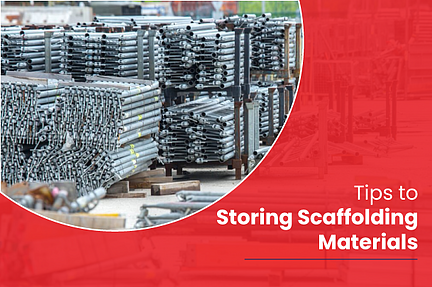
When you’re executing a construction project, you will need materials and many components. But when you disassemble the scaffolding structure, you have to store parts in a better way. If you don’t store scaffolding materials safely, then rust can ruin them. Just imagine the danger workers will have to face if scaffolding loses its structural strength. Workers may fall down suddenly and unknowingly. So, in this article, you will know about storing scaffolding material.
How Should Scaffolding Materials be Stored?
When you wish to store scaffolding materials, you must ensure proper storage. You may think about a yard for keeping the materials safe. But, due to the outdoor climatic conditions, the material will tend to wear out. Hence, here are some practices you must follow.
Always Clean The Materials Before Storage
As you plan to store scaffolding materials, clean them thoroughly. Try removing paint residues or dirt to prevent future deterioration. You should also remove moisture from the material. Once you commence inspection, observe different parts, locking pins, and welds properly. If you observe any damage, then replace the part immediately. This step will ensure safety and prevent damage to other scaffolding components.
Consider Labeling And Organizing The Parts
It can be quite time-consuming to find a scaffolding component inside a warehouse. So, before you start storing the parts, organize everything carefully. Additionally, you need to paste labels for quick identification. In the end, you have to segregate scaffolding parts to mitigate damage before using a scaffolding storage system.
Store Components In A Dry Area
Scaffolding materials and components can corrode due to moisture. But if the parts are galvanized during the manufacturing process, then they can sustain humid zones and some rain. On the other hand, we suggest you store the parts, like toeboards or wooden planks, in a dry area. Besides, consider wrapping with thick covers before storage. These covers should be capable enough to protect the equipment against humidity and rainfall. Besides, you must ensure that the area is well ventilated. This can prevent the space from becoming humid. If you overlook this tip, then water droplets can cause rusting.
Ensure Ease Of Access
Scaffolding parts can be tough to find if they are spread out. There’s always a likelihood that the parts will get damaged. Hence, it’s always a good idea to keep them in a place where you can easily find them. This will save considerable time and effort in the future. Storing scaffolding components high on the stacks can also make them fall. In fact, when components fall, they can cause injuries and unexpected incidents.
Never Keep Scaffolding Components Near Doors
Whenever an emergency arises, workers have to evacuate the space quickly. They have to run to the doors as early as possible when everything becomes chaotic. Blocked exits can delay rescue operations to a certain extent. Therefore, you should properly organize the parts and use a scaffolding storage system. Think about placing them in such a way that there’s sufficient space to go through the doors. You should also make sure that the parts don’t block the safety signs. By blocking the doors, you will be violating certain regulations as well.
Avoid Storage When Moist
Always wipe scaffolding components dry to prevent decay and rust. When it comes to scaffold planks, storing them when they are wet increases the chances of fungal decay. Rot may also buildup and ruin the quality of the parts. Moreover, you should use scaffold storage racks for the planks so that ample air circulates around them. Keeping the boards dry will prevent rotting and rust buildup.
Avoid Storing When Parts Are Wet
Before you begin storing the components, ensure that they are not wet. Keeping scaffold planks damp also leads to fungal decay. Care should also be taken, particularly when you’re about to store scaffold planks. Once the components start rotting, the impact can ruin them and affect their quality. To clean the scaffolding components, you can use compressed air or a brush. Later, you can wipe the surfaces with a damp cloth.
Conclusion
You should be clever while storing scaffolding components. You can use pallets to keep the space tidy when the parts are organized properly. But, a step further, you can set the pallets the way you want, depending on the materials. Alternatively, you can keep scaffolding parts on flat surfaces to reduce the chances of bending. In those instances, you should ensure that the surface is even. If the surface is uneven, then it can make the materials and components weak.
Go For Scaffolds Supply
Are you still seeking high-quality scaffolding materials? Well, you can approach Scaffolds Supply right away. Our team specializes in scaffolding components and materials. We have extensive knowledge about types of scaffolding and industry standards. With the range of options that we provide, you can choose the best suited to the project’s scope and your needs.











Comments are closed